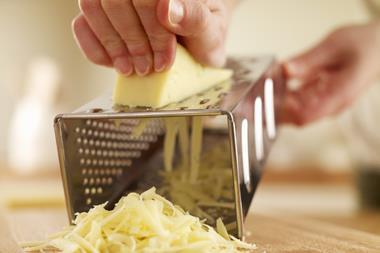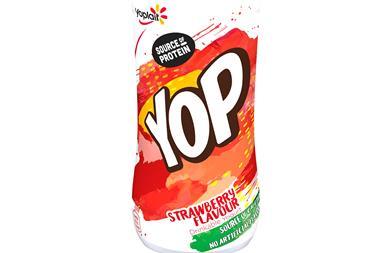We’re a nation of fridge botherers, apparently. The average fridge door is opened 42 times a week whereas the average cupboard is opened a mere 22 times, according to analysts Nielsen. How many times this door-twitching amounts to nothing more than a fruitless search for ‘something exciting’, which you know you haven’t actually bought, isn’t stated, but it is clear that the British consumer is still keen on all things chilled. And one of those chilled offerings that the Brits are particularly keen on is cheese, which is the fourth biggest sector in the £2.6bn convenience chilled sector.
35%
of cheese snacks are consumed as part of lunchboxes by adults and children, according to Kantar Worldpanel
It seems we can’t get enough of the hard/soft/spreading/stringy stuff, with 98% of the population buying cheese every 10 days, according to Nielsen/Kerry. This has created a buoyant category, with the total cheese market rising by more than 30% between 2007 and 2012 (Mintel).
Cheddar continues to dominate, accounting for half of volume and value sales in the total cheese market, with 80% of consumers buying into it, says Mintel. And while the sector has been hit by rising milk prices, the market has been helped by NPD and the introduction of cooking occasion concepts.
Mintel reports that 40% of consumers say that they use cheese in cooking or pasta, while the majority are using cheese in sandwiches and 70% on toast.
According to Wyke Farms managing director Rich Clothier, growth in the market comes from both the value end of the market and quality home dining. He says: “These trends cement the need for a good strong pricemarked everyday low price offer, backed up by a quality offering across Cheddar, through additives and regional. Value and choice are paramount.”
Retailer’s view
“Cheese is probably one of the three or four very important components within chilled. We tend to have four long-term promotions on cheese and one or two three-week promotions. We see an upswing in sales when they’re on.
“Different people buy different types of cheese, and older people tend to be the most adventurous. They’ll go for something other than Cheddar. They’ll often have a Wensleydale as their staple, then go for something like a French brie, camembert or stilton.
“It’s coming up to a busy time for the section now. At Easter people buy more than they usually would both for cooking and because they’ve got relatives coming. We sell a massive range as a result, from £2-£3 up to speciality cheeses such as £9 stilton.
“Lunchbox types of cheese also do well and we sell Dairylea Triangles and Slices, as well as Bel and Cheestrings.”
Rav Garcha, four stores in the West Midlands
According to Bel head of category management Stephen Gregory, buying for tonight is the key. “Cheese has been performing well, but it’s really been driven by a change in shopper habits and the arrival of the buying for tonight trend,” he asserts.
He says these customers are looking for more variety and choice. “Since the beginning of the current economic woes a lot more people have been cooking at home, but they’re becoming bored with what they’ve been making. It’s appealing to this variety, which is why the multiples are doing so well.”
Clothier says that the biggest challenge for convenience is matching the value and choice of the multiple convenience store. “A consumer’s needs from cheese in convenience are complex and it requires a more complex range than other categories. This means that it is space hungry in store. This can be helped by focusing on a quality mature Cheddar as hero, and avoiding duplication in ranging. We try to engage retailers by offering options on size ranges and price points. It’s simply no good for them to copy the multiple retail ranges.”
Gregory advises retailers to use their space well. “If you’ve got space for five cheeses make sure that those five cheeses represent variety. You need a cooking cheese, an indulgent cheese, and a snack cheese. Cover off those shopper missions. Then it’s not a question of competing with the multiples. The golden basic rule is range.”
Kerry Food shopper marketing director Sue McVie points out that the British market is still falling a long way short of our European cousins: “There is still significant room for category growth, particularly when drawing comparisons with similar sized European markets. By just consuming an additional 20 grams per person each week, we could add £450m to the category.”
And Clothier adds that the cheese market could do a better job in responding to the needs of the convenience market in Cheddar. He says: “I think that many cheese suppliers/brands are producing multiple retail ranges and ‘shoehorning’ them into convenience. We try not to do that. We try to offer smaller sizes and different pricing matrices.”
Top tips
• Cheese doesn’t begin and end with Cheddar blocks - make sure you offer something for snacking, lunchbox and the cheeseboard, plus sliced and grated formats
• Don’t leave out cheese when it comes to meal deals, and consider cross-merchandising certain cheeses. Try snacking for a food-to-go deal, or cooking cheese or a blue cheese for a dining-in deal
• Four out of five buyers eat cheese in a sandwich and seven out of 10 have it on toast (Mintel) so second site bread near your chiller
• Create ‘mission’ blocking by situating cheese products next to other chilled lunch box top-up categories such as sliced cooked meats and spreads
• Know your cheese customers: women, over-55s and high earners are key cheese buyers who will venture outside the blocks.
Source: Kerry Foods, Mondelez, Bel
Last year the Wyke Farms brand underwent a revamp featuring a new brand identity designed to increase shelf impact and improve block branding.
McAvie says that the way to achieve success in block cheeses is extending usage. “Block Cheddar remains a promotion-driven commodity, but by extending usage occasions with convenient formats such as grated, slices and spreadable which are purchased alongside traditional formats, and by educating consumers, we can drive value growth,” she says.
Another key trend which continues to provide healthy sales is snacking, a relatively new sector in the cheese market. “Just over 15 years ago, the cheese snacking category didn’t exist, but it’s now worth £194m and continues to grow. With convenience, cheese snacking remains a brand-led category, with more than 90% of sales coming from the top three brands,” she points out.
Ones to watch
Ring the changes
Bel has turned to radio and TV with its new marketing campaign to back Laughing Cow Light with Blue Cheese. The variant has proved popular in testing among adults and dieting women. The TV ad campaign runs for another four days, but advertising continues on the radio until May.
tel: 0333 900 2024
String time
Kerry Foods is extending its Cheestrings brand with new cheese & onion and cheese & tomato flavours. The brand as a whole will continue to be supported by a heavyweight marketing campaign throughout the year, targeting the key Easter and back-to-school periods in particular.
tel: 01784 430777
Public’s choice
The Wyke Farms brand has has had a revamp with designs being put to public vote via the company’s Facebook community. The cheesemaker has used the winning design on all its packaging. This year, the Wyke Farms brand will be sampling at 37 events throughout the year.
tel: 01749 813614
One to dip into
Philadelphia with Cadbury caused a stir last year when it was launched in February and Mondelez followed it up in August with the launch of its snacking variant. The packs contain 50g portions of Light Philadelphia with Cadbury chocolate and mini oaties for dipping.
rrp: 69p
tel: 08702 400 861
Heroes welcome
Wyke Farms has teamed up with Help for Heroes, the UK charity which provides support for wounded soldiers, with two products carrying its logo. Special packs of Mature Cheddar for Heroes, which are distinctively marked, will include a minimum of 7p donation to the charity.
tel: 01749 813 614
McVie says that the Cheestrings brand is continuing to drive growth in the channel, with the brand up 7% and outperforming the market as a whole by 1%. However, the company says that only 7% of lunchboxes contain a cheese snack, a fact the company hopes to change with its forthcoming April launch: an extension to the Cheestrings range with two new flavours, cheese & onion, and cheese & tomato.
Another lunchbox favourite, Bel’s The Laughing Cow, took a sophisticated turn last year with the introduction of a lighter blue variant. Gregory says that there’s often a misconception about cheese spreads, particularly those that come in triangles. “One of the biggest surprises about The Laughing Cow is that almost half of its sales are due to adult consumption, particularly women watching their weight.”
He says that the launch of the lighter blue variety came after research showed interest in extending the brand with different cheese types, rather than by including other foodstuffs to go with it such as ham. “Blue was the strongest variant to come out of the research and performed very well,” Gregory adds.
He says that NPD from all manufacturers is really helping to drive the market and engage shoppers. “There’s going to be NPD in response to the major market trends of health, variety and cooking at home,” he predicts.
According to Mintel, the market looks to continue growth over the next five years, helped in part by an ageing population who are core users of cheese.
To meet the challenges of the market, retailers should be focusing on value and choice, says Clothier. “It’s making sure that when the shopper wants an item they have it, and making sure that it’s at an everyday low price so that the shopper does not feel price punished for running short and having to shop in the convenience store.
“Really successful convenience retailers are increasingly focusing on provenance, and by stocking ranges from small local suppliers are becoming hubs of the community and a really valued part of the local fabric of the community in the way that traditional grocers would have been.”•



























